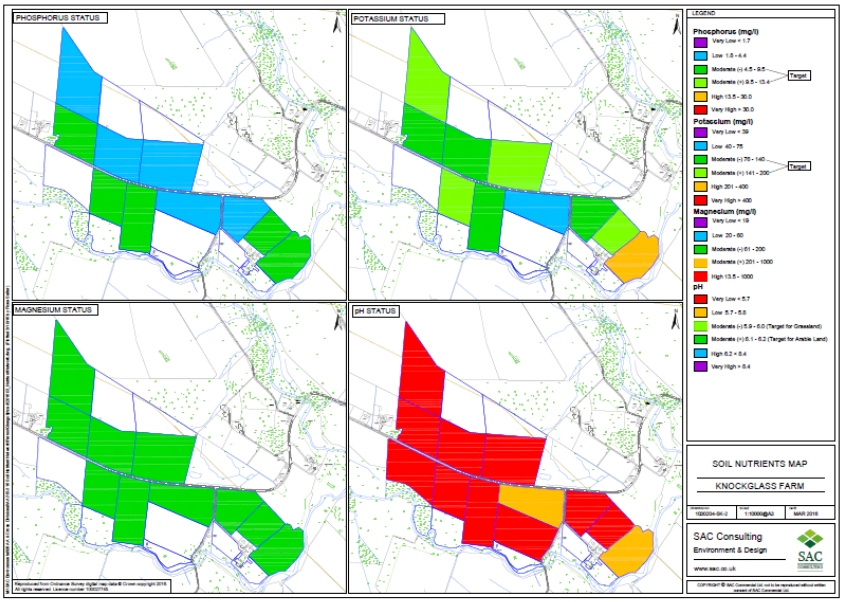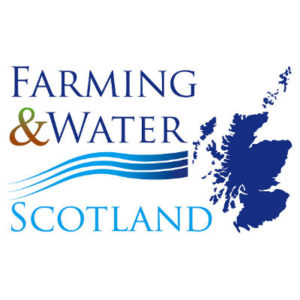Soil & Nutrient Network – Case Study: Knockglass Farm Nr Thurso
3 June 2017Introduction to Knockglass Farm
Knockglass Farm near Thurso, Caithness was purchased by brothers Robbie and Andrew Mackintosh in May 2015 as they sought to increase their farming enterprise. They already have land at Glengolly, Houstry and Gelshfield. The 67.50ha purchased at Knockglass took their total farming enterprise to 205ha with an additional 52ha taken on seasonal land. They farm approximately 90 cows and 1000 ewes.
At the first meeting in March 2016, the brothers were keen to focus their attention on the nutrient status of the land at Knockglass as it had been let out for grazing for 10 years prior to their purchase. Here we consider at some of the findings and key points discussed at the meeting.
2017 Greening – nitrogen fertiliser and lime plan
There are new rules regarding greening and the production of a nitrogen fertiliser and lime plan. This requirement means farmers with fields of wholly permanent grassland on their Single Application Form must now prepare a plan detailing the amount of inorganic fertiliser and lime they intend to apply to each permanent grassland field. It must be completed by 9th June
2017 and available for inspection but the plan does not need to be submitted to SGRPID.
Know your soil nutrient status
The soil analyses at Knockglass revealed the nutrient status across 12 fields on the farm. Knowing soil nutrient status allows you to make best use of slurry, manures and bought in fertiliser, helping you to target their application where it is needed.
If soil pH, P and K are lacking, then N cannot be utilised to its full effect, you will not get the yields you are targeting. Ultimately it will be costing you money to apply N for little gain.
For P and K, targets are to aim for a Moderate status, especially if you need more grass, or are using good levels of Nitrogen fertiliser each year. For a lower intensity system, where little or no N is being spread, then the target is to maintain your existing P and K status – i.e do not allow it to drop further.
So if you do not know your pH, P and K status, then you cannot make informed decisions on grassland management – the key message here is to get your soil analysed and prepare a nutrient budget.
What did soil testing tell us at Knockglass?
Of the 12 fields sampled, the results above showed that the key issues for land at Knockglass are its pH and its P status. The soil analyses and gave Robbie and Andrew a clear picture of the land they had taken on and next steps to improve productivity.
Soil testing showed that:
- Ten fields were very low for pH
- pH ranged from 5.3 – 5.8
- All fields were either low or moderate for P
- Ten out of 12 fields were moderate for K
For more information on the Soil and nutrient Network see Farming & Water Scotland
For dates of SNN events, find us on Facebook or follow us on Twitter @FASScot ![]()
![]()
- Valuing Your Soils – Practical Guidance for Scottish Farmers
- This brochure includes useful information about Scotland's agricultural soils and practical advice outlining the upfront financial savings and business benefits of better soil management and the efficient use of resources. Action and problem-specific 'field-sheets' are designed for busy farmers with limited time for reading.
- Topics: Climate Change, Soils, Water Management and Crops and Soils
- Visual Evaluation of Soil Structure (VESS) Score Chart
- This is a downloadable copy of the Visual Evaluation of Soil Structure (VESS) score chart for use in-field.
- Topics: Soils
- Practical Guide: Soil sampling I – How to take a soil sample
- This practical guide details what is required to take a soil sample for analysis that is representative of the area sampled.
- Topics: Climate Change, Soils and Water Management
- Practical Guide: Soil sampling II – Benefits to your business
- This practical guide details how soil sampling can benefit businesses by increasing productivity and create efficiencies on fertiliser inputs through better nutrient planning.
- Topics: Climate Change, Soils and Water Management
- Practical Guide: Nutrient budgeting I – The Benefits to your Business
- This practical guide looks at the benefits of creating and using a nutrient budget for your farm business.
- Topics: Climate Change
- Practical Guide: Nutrient Budgeting II – Getting Started
- This practical guide looks at what factors you need to consider when making a nutrient budget for your farm, fertiliser recommendations and how to get the most out of your nutrient budget.
- Topics: Climate Change
- Technical Note (TN656): Soil Information, Texture & Liming Recommendations
- • Web based access to information on your soils on your farm is described. • Soil texture classes of mineral soils are described and identified by hand texturing. • Liming recommendations for different soils and managements are tabulated.
- Topics: Soils
Sign up to the FAS newsletter
Receive updates on news, events and publications from Scotland’s Farm Advisory Service






